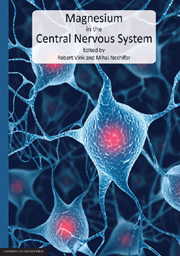Book contents
- Frontmatter
- List of Contributors
- Preface
- Contents
- Section 1 Magnesium in Normal Brain
- Section 2 Magnesium in Neurological Diseases
- Chapter 7 The role of magnesium therapy in learning and memory
- Chapter 8 The role of magnesium in headache and migraine
- Chapter 9 Magnesium in edema and blood-brain barrier disruption
- Chapter 10 Magnesium and hearing loss
- Chapter 11 The role of magnesium in pain
- Chapter 12 The role of magnesium in traumatic CNS injury
- Chapter 13 The use of magnesium in experimental cerebral ischaemia
- Chapter 14 Magnesium in subarachnoid hemorrhage
- Chapter 15 Magnesium in clinical stroke
- Chapter 16 Magnesium in cancer: more questions than answers
- Chapter 17 Magnesium in Parkinson's disease: an update in clinical and basic aspects
- Section 3 Involvement of Magnesium in Psychiatric Diseases
Chapter 17 - Magnesium in Parkinson's disease: an update in clinical and basic aspects
from Section 2 - Magnesium in Neurological Diseases
Published online by Cambridge University Press: 05 June 2012
- Frontmatter
- List of Contributors
- Preface
- Contents
- Section 1 Magnesium in Normal Brain
- Section 2 Magnesium in Neurological Diseases
- Chapter 7 The role of magnesium therapy in learning and memory
- Chapter 8 The role of magnesium in headache and migraine
- Chapter 9 Magnesium in edema and blood-brain barrier disruption
- Chapter 10 Magnesium and hearing loss
- Chapter 11 The role of magnesium in pain
- Chapter 12 The role of magnesium in traumatic CNS injury
- Chapter 13 The use of magnesium in experimental cerebral ischaemia
- Chapter 14 Magnesium in subarachnoid hemorrhage
- Chapter 15 Magnesium in clinical stroke
- Chapter 16 Magnesium in cancer: more questions than answers
- Chapter 17 Magnesium in Parkinson's disease: an update in clinical and basic aspects
- Section 3 Involvement of Magnesium in Psychiatric Diseases
Summary
Abstract
Magnesium (Mg) is essential for cell functions such as transport of calcium and potassium ions, and modulates signal transduction, energy metabolism, and cell proliferation. Several studies elucidated a reduced concentration of Mg in patients with Parkinson's disease (PD), and experimentally, severe loss of dopaminergic neurons exclusively in the substantia nigra in 1-year-old rats that had been subjected to continuously low Mg intake (one-fifth of the normal level) over generations. A study conducted by the authors revealed a significant and striking effect of Mg to prevent neurite and neuron pathology, and also to ameliorate neurite pathology in a rat Parkinson disease (PD) model involving culture of ventral mesencephalic-striatal cells with 1-methyl-4-phenylpyridinium (MPP+). Mg is expected to prevent and ameriolate Parkinson's disease in cases where it would be able to cross into the brain in a suitable way.
Introduction
Parkinson's disease (PD) is a neurodegenerative disease occurring in middle-aged and aged humans characterized by clinical symptoms including tremor and rigidity (Parkinson, 1817). It has been reported that almost 90% of the patients are sporadic and 10% are familial. Sporadic PD shows neuropathological features involving the appearance of Lewy bodies (Lewy, 1912; Tretiakoff, 1919) and loss of neurons in the substantia nigra (Figures 1 and 2) and substantia innominata.
- Type
- Chapter
- Information
- Magnesium in the Central Nervous System , pp. 229 - 236Publisher: The University of Adelaide PressPrint publication year: 2011
- 4
- Cited by

